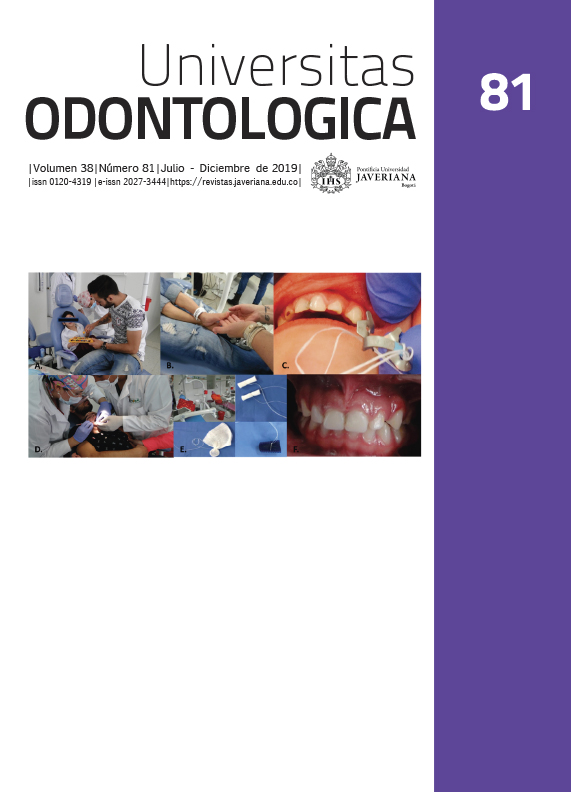Abstract
Background: Traditionally, a series of steps have been carried out to make a complete denture, which are still essential despite technological advances. However, in some patients it is difficult to adapt new dentures. Objective: To describe a simplified technique for the duplication of total dentures using thermo-cured acrylic. This technique seeks to preserve intraoral mechanoreceptors and muscle adaptation that a patient has managed for years with the old dentures. Case description: A patient with severe bone resorption in both jaws needed to change 20-plus-year-old dentures. Duplicators similar to 3i® were made to obtain copies similar to the patient’s dentures. Simultaneous impressions of both jaws with closed mouth were taken. The definitive thermo-cured dentures similar to the patient’s old ones maintained neurosensory physiology and the patient did not feel the change. Conclusions: Conservation of the sensory receptors such as cold, pressure, heat and muscle activity is essential for success in cases of denture duplication. The author has around 2500 cases of denture duplication in a more than-20-year practice.
2. Matiz Cuervo J. Duplicación de prótesis. México, México: El Manual Moderno; 2016.
3. Davis DM, Watson RM. A retrospective study comparing duplication and conventionally made complete dentures for a group of elderly people. Br Dent J. 1993 Jul 24; 175(2): 57-60.
4. Davenport JC, Heath JR. The copy denture Technique. Br Dent J. 1983; 155: 162-163.
5. Brill N, Tryde G, Schubeler S. The role of exteroceptors in denture retention. J Prosthet Dent. 1959; 9(5): 761-8.
6. Robinson JG. A denture copying technique when providing replacement dentures. J Dent. 1976; 4(1): 15-8.
7. Lindquist TJ, Ettinger RL. Patient management and decision making in complete denture fabrication using a duplicate denture procedure: a clinical report, J Prosthet Dent. 1999; 82: 499-503.
8. Scott BJJ, Forgie AH, Davis DM. A study to compare the oral health impact profile and satisfaction before and after having replacement complete dentures constructed by either the copy or by the conventional technique. Gerodontol. 2006; (23): 79-86.
9. Lindquist TJ, Narhi TO, Ettinger RL. Denture duplication technique with alternative materials, J Prosthet Dent. 1997; 77: 97-8.
10. Heath JR, Basker RM. The dimensional variability of duplicate dentures produced by an alginate investment. Br Dent J. 1978; 144: 111-4.
11. Heath JR, Davenport JC. A modification of the copy denture technique. Br Dent J. 1987; 153: 300-2.
12. McCord JF, Hannah VE, Cameron D, Watson D, Donaldson AC. An update on the replica denture technique. Dent Update. 2010 May; 37(4): 230-2, 235.
13. Duthie N, Lyon FF, Sturrock KC, Yemm R. A copying Technique for replacement of complete dentures. Br Dent J. 1976; 144(8): 248-52.
14. Ansari IH. Duplicating an existing complete denture to make a replica. J Prosthet Dent. 1994; 72(4): 445-7.
15. Boos RH, Carpenter HO Jr. Technique for duplicating a denture. J Prosthet Dent. 1974; 31(3): 329-34.
16. Adam CE. Technique for duplicating an acrylic resin denture. J Prosthet Dent. 1958 ; 8(3) : 406-10.
17. Koka S. Vertical dimension of occlusion. Int J Prosthod. 2007; 20(4): 342.
18. Misch C. Objective vs. subjective methods for determining vertical dimension of occlusion. Quintessence Int. 2000 Apr; 31(4): 280-2.
19. Zoeller GN, Beetar RF. Duplicating dentures. J Prosthet Dent. 1970; 23(3): 346-54.
20. Chamberlain JB, Basker RM. A method of duplicating dentures. Br Dent J. 1967; 122: 347-9.
21. Singer LI. The “zipper” technique for duplication dentures: Final impressions, replica dentures, and a complete denture splint. J Prosthet Dent. 1975; 33(5): 582-90.
22. Nassif J, Jumbelic R. Duplicated maxillary complete dentures. J Prosthet Dent. 1984; 52(5): 755-9.
23. Kawahata N, Ono H, Nishi Y, Hamano T, Nagaoka E. Trial of duplication procedure for complete dentures by CAD/CAM. J Oral Rehab. 1997; 24: 540-8.
This journal is registered under a Creative Commons Attribution 4.0 International Public License. Thus, this work may be reproduced, distributed, and publicly shared in digital format, as long as the names of the authors and Pontificia Universidad Javeriana are acknowledged. Others are allowed to quote, adapt, transform, auto-archive, republish, and create based on this material, for any purpose (even commercial ones), provided the authorship is duly acknowledged, a link to the original work is provided, and it is specified if changes have been made. Pontificia Universidad Javeriana does not hold the rights of published works and the authors are solely responsible for the contents of their works; they keep the moral, intellectual, privacy, and publicity rights.
Approving the intervention of the work (review, copy-editing, translation, layout) and the following outreach, are granted through an use license and not through an assignment of rights. This means the journal and Pontificia Universidad Javeriana cannot be held responsible for any ethical malpractice by the authors. As a consequence of the protection granted by the use license, the journal is not required to publish recantations or modify information already published, unless the errata stems from the editorial management process. Publishing contents in this journal does not generate royalties for contributors.



